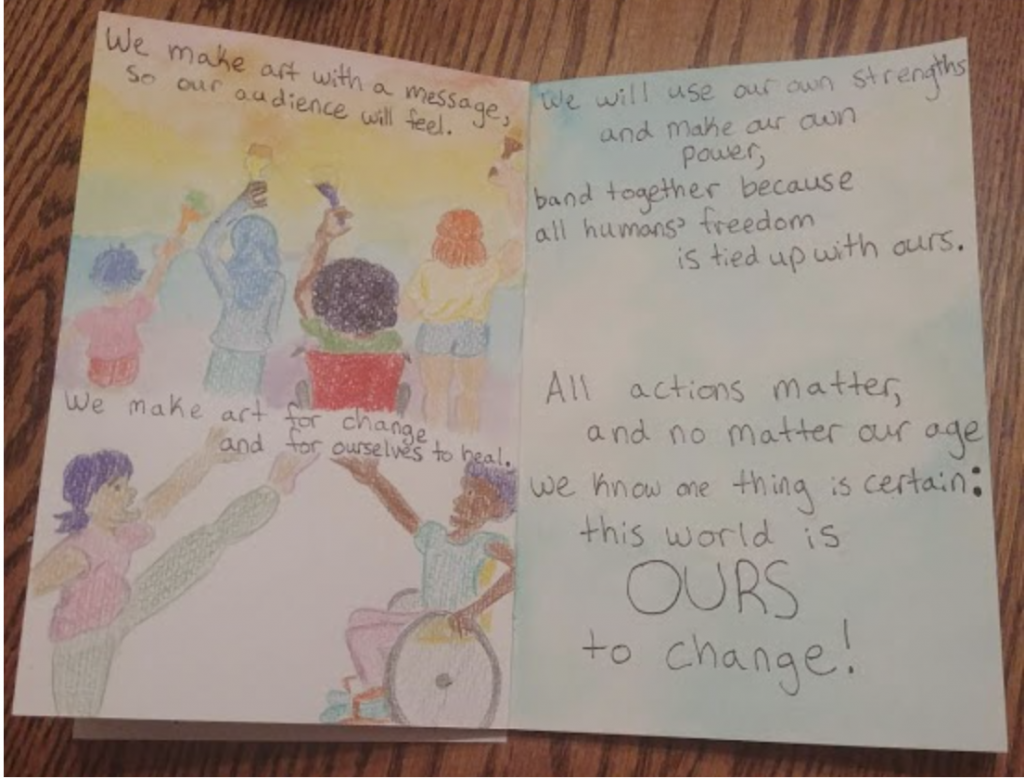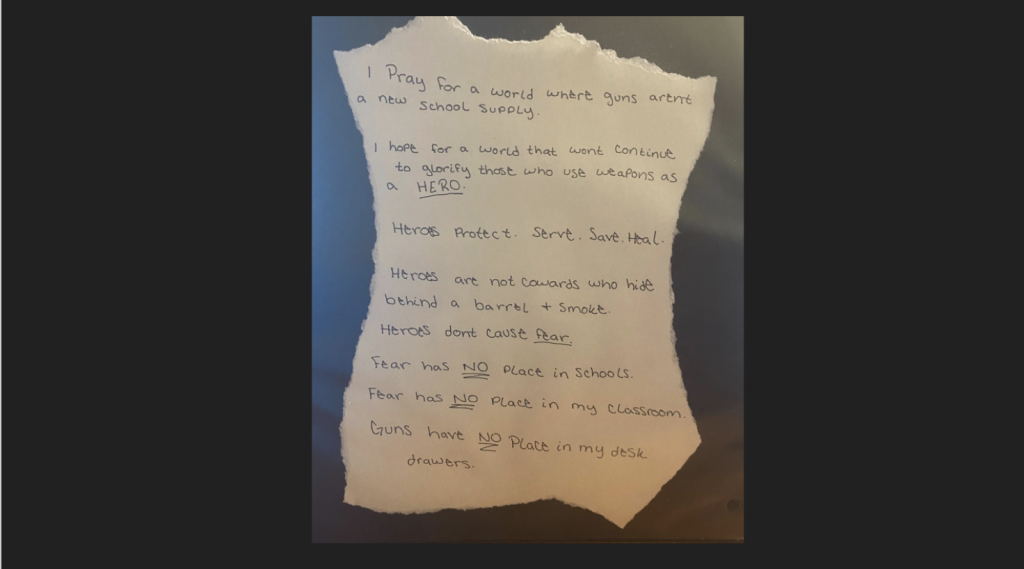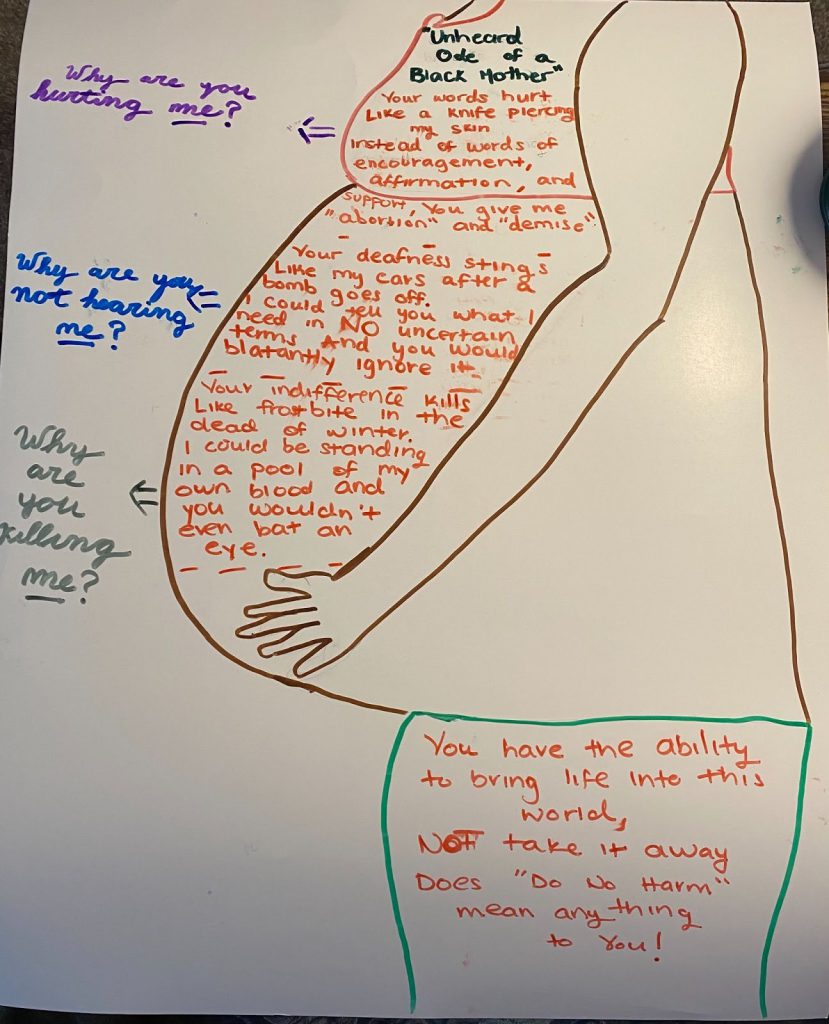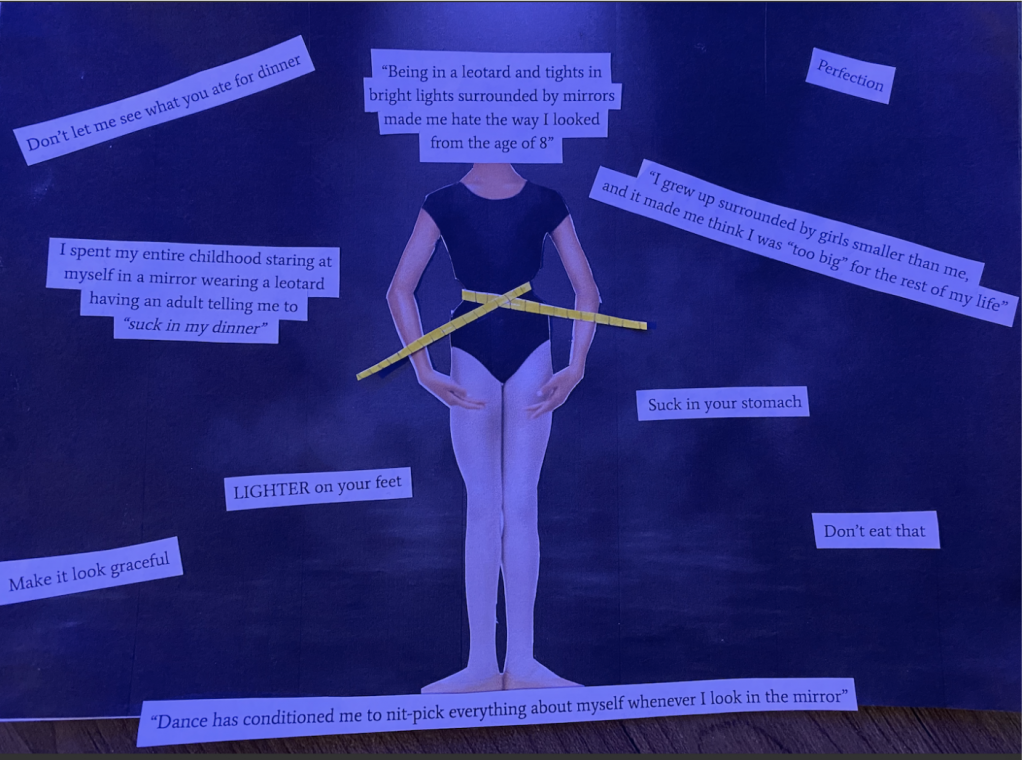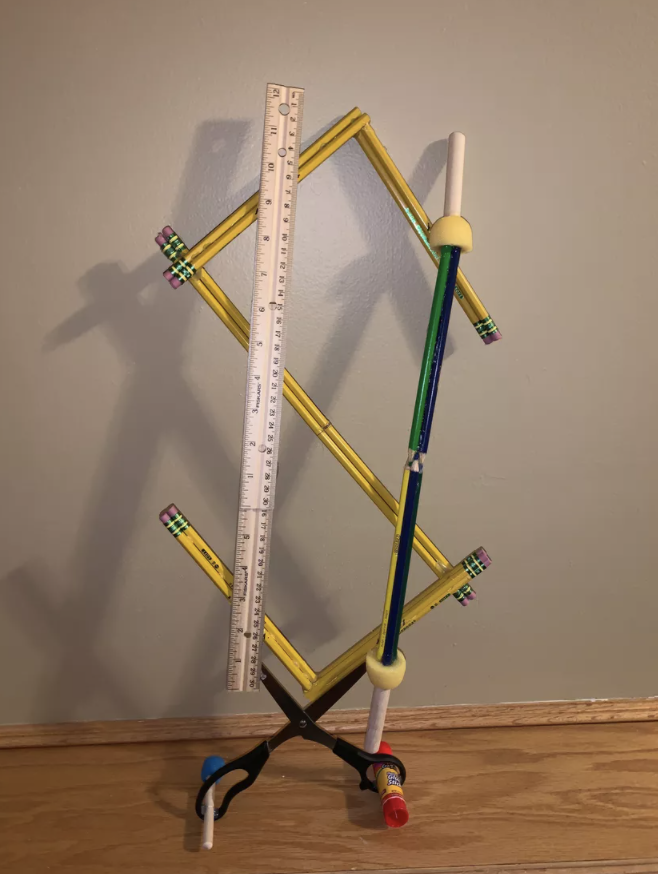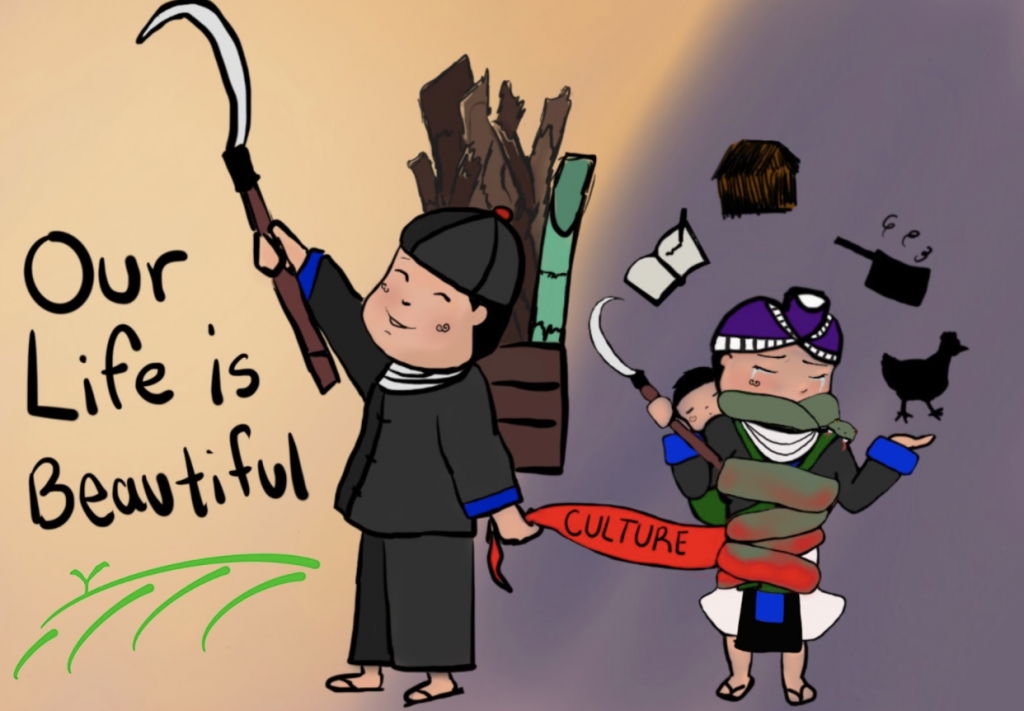Students taking Linda Buturian’s course, CI 1032: “Creating Identities: Learning in and through the arts” spent this spring semester discovering how to use art as a means to understand social issues and inspire change. They created and analyzed art to understand how personal and social identities impact the ways in which people learn. The final project asked students to use the creative medium of their choice to reflect on a social justice issue.
Several students (many of whom are elementary education majors) focused their project on education-related issues, combining their passion for social justice in education with an arts-based approach to expression. Featured below are a sampling of the final projects:
The World is Ours to Change by Emma Maki
Artist Statement:
“The topic I am addressing with the children’s book, The World is Ours to Change, is youth activism. Oftentimes, young people are disempowered due to their age. Adults may address them as “citizens in the making” – or people who will one day become adults and thus have the skills and power to create change. Arguably worse, youth are sometimes viewed through the deficit stereotype of being uninterested in and unknowledgeable of the conditions of the world around them. In reality, young people are smart, are skilled, and are powerful. They have valuable funds of knowledge, passions, and lived experiences, and they are already people capable of change – whether teenagers in high school or four-year-olds in preschool. Thus, I advocate for support to youth to empower them through activism. Here, I define youth as a demographic of people who may feel disempowered because of their relatively low age. I define activism as the process of empowerment in which people identify a change they want then work to bring it into existence.”
See a video of Emma reading her children’s book.
Malaya Merriwether

Artist Statement:
“My journey of accepting and loving my racial identity can be seen through the evolution of my hair. Growing up as one member of the 1% Black population in my hometown, it was important for me to eliminate, as best I could, any aspect of my appearance that made me different from my peers. At this point, I saw my big, poofy, hair as a flashing neon sign, reminding everyone around me of my Blackness. For this reason, I tried very hard to conceal my curls and to embody the eurocentric beauty standards that surrounded me. Clearly, after 20 years, I am now very proud to be a Black woman and it gives me pride to wear natural or braided hairstyles. Even with this new-found self-love however, I, like many other Black woman and men, suffer discrimination because of my hair. Three weeks ago when I went home to visit my family, I got my hair braided. Following my appointment, I felt beautiful and strong. Before I could make it home, I was sitting at a red light and an old man rolled down his window in the car next to me and cursed at me and called me a horrific slur that all Black people know far too well. This was a reminder to me that no matter how much love Black woman develop for their hair, it will continue to be used against us to facilitate racism and discrimination. This event inspired me to create this art piece, showcasing the intimate relationship that Black women have with their hair.”
Notebook, Pencil, Hand Gun? Check. by Nicole Olesen
Artist Statement:
“As someone who isn’t the most artistic, who isn’t the ablest to express themselves in words, I am someone who has a big heart that cares for the lives of my future students. I see myself as a teacher in the hallways and a teacher in life who truly cares about the well-being of others. Why would I be the one to take away someone’s life? My passion is to educate those on how to be good people, not to pull a trigger in front of those tiny eyes and souls…I don’t feel that making schools become more and more like a prison is something we should want for our students. I don’t think anyone wants to see our schools become a place where kids don’t feel safe. Where they don’t enjoy recess or going to art class. They shouldn’t fear the thing they love the most. We as teachers shouldn’t be armed with guns to protect our students, we shouldn’t need to include guns in our school supply lists. My desk is not meant to be filled with ammunition next to the bandaids, cough drops, and sparkly star stickers that are put on my student’s homework for doing a good job. I think we need to remove the middle man here. And remove guns from the equation.”
Vulnerability of Black Mothers by Lisa Ongondi
Artist Statement:
“I am a young black woman who hopes to have children someday. I am surrounded by black women who have given birth in the hospitals of this country. They and I live in a world plagued by inequalities, microaggressions, and discrimination that seeps into nearly every system we use for our betterment and survival. No institution is left out-not the education system we use to educate ourselves and our children, not the workplace we go to to earn a living, and definitely not the healthcare system we seek to start our families, find healing, or repair our bodies. I wanted to focus on that last system-the healthcare system-for my Art for Social Change project because of the real threat it poses to the black women I cherish so dearly. There is an assault taking place in the United States against maternal health care, particularly against BIPOC mothers. One big reason this is occurring can be best explained by a quote I took from a UChicago article on health disparities: “systemic racism impacts access to quality healthcare”. According to the CDC, “Black, American Indian, and Alaska Native (AI/AN) women are two to three times more likely to die from pregnancy-related causes than white women”. This trend needs to stop, but it cannot until we are aware of what is going on, so that is my reason for pursuing this topic.
I asked multiple black mothers who have given birth in a US hospital via Facebook and text to tell me their negative experiences related to racism and discrimination during their labor and delivery. I took those stories and inserted certain words, feelings, and phrases and put them into my poem. I then proceeded to write a poem on the silhouette of a black pregnant mother and write it as if she experienced all of these things in her labor experience. I wrote the poem in red to symbolize the blood the healthcare workers have on their hands when they reduce the quality of healthcare by acting on their prejudices and biases.”
Emma Pollei and Sydney Schroeder
Artist Statement:
“For our topic, we chose to focus on dance, something we have both done our whole lives and something we are very passionate about. We think it is very important to discuss how the sport tends to shed a very negative light on body image and how that can lead to high levels of eating disorders in the sport. We chose this topic because we have seen how dance has affected us in different ways, of course positively, but also negatively regarding body image and confidence. We have seen this directly impact us, as well as people in our lives and think it is an important conversation that should be had. Dance is often advertised as an activity for young children to gain confidence and artistry, but it is clear that at the competitive level, this sport can do more harm than good when it comes to body image and mental health of these dancers later in adolescence. Our title came to us when we realized how many dancers talked about the fact that their teachers would always say comments such as “don’t let me see what you ate” or “suck in your stomach.” This constant talk and shaming of stomachs to even very little girls sticks with them for life and that talk never leaves their minds. From all of the responses we received, all touched on the negative impacts that dance has left on them regarding body image and confidence, even though some of these people have been out of the sport now for 2+ years.”
Funding Scissors by Joe Sherry
Artist Statement:
“I was inspired to create a sculpture after visiting the Franconia Sculpture Park. I liked the idea of having a physical piece of art that could be touched and experienced. My sculpture was created with items that are commonly found in an elementary school classroom. I tried to include various school supplies that are symbolic of the educational experience for a child. My favorite part of the sculpture is the scissors that hold it up. The main part is shaped like a dollar sign to represent education funding and budgets. The scissors have a double meaning. They represent the cutting of the education funding in Minnesota in general, as well as the Minnesota legislators. Since 2003, the amount of state aid that districts receive per pupil has decreased. This state aid makes up roughly 70% of a district’s funding in Minnesota. When this large part of school districts’ budgets began to decrease, the burden was placed on local tax payers to make up for the lack of funding. While some districts have the tax base to make up for this lack of funding, that is not the case for all districts. Many districts do not have the tax base to support the additional needs, which results in program, equipment, and staffing cuts. These cuts have negative impacts on the students in those districts. They often have fewer chances for one-on-one help, extracurricular activities, and adequate supplies/technology. These funding issues widen the gap in education and provide vastly different experiences for students in Minnesota. Many low income areas fall behind academically, while the high income areas accelerate. A solution for this would be for state legislators to increase the amount of education funding and make it more equitable. Many politicians make comments along the lines of “The children are our future”, yet they have turned and reduced the funding schools receive from the state level. They are the scissors that are holding education up, while cutting it down at the same time. My hope is that my art inspires you to look at the education funding in your community and advocate for equitable funding across the state of Minnesota.”
Transcending to Beauty by Allison Xiong
Artist Statement:
“My comic strips are inspired by the interview with my husband’s family since conveniently I live with them. My conversations with them have brought an epiphany to my social justice resolution on the conflicts in my Hmong culture. This interview has shown me three important things. One, the Hmong culture needs to evolve to a more appropriate system that reflects on today’s insights. Two, the gap between the old and young generation is due to the lack of opportunities and resources. Thirdly, Hmong women and children are not demanding for Hmong men to drop their power and privilege to zero or to completely change the Hmong culture. We want to transcend beyond and find justice and establish equity together…From a broader perspective from what I know as a Hmong American daughter, sister, wife and mother I’ve experienced and witnessed various degrees of how my Hmong culture has oppressed, deprived, and widened the gap among our Hmong community. The older and younger generations often fight over on how our culture should be drawn, sewn, and colored. Disputes lead to changes, but currently we are all on the run neglecting the needs of our Hmong community and losing a part of our identity. Our young generation is working the hardest in molding two different cultural practices together, and our older generation are tirelessly juggling between reality and trauma. And when we come together we argue, we yell, we point, we blame, we turn around and hope that next time the other will understand our needs. Life as a Hmong person is not easy. We have no claimed country, we only blend among the crowd, and opportunities given have only been about sacrifices and loneliness…After my interview and thought processing, I created comic strip scenes to show the harm and struggle of the Hmong culture, the demand and action of justice and equality, and the concept of taking the opportunity to evolve the Hmong culture. My goal is to show that culture is created by the people within the community so all voices and actions should be reviewed with equity and grace. My hope is that when we have made the choice to come and do the work together, we can look at what we created and say that it was a beautiful journey together. Because the Hmong culture is beautiful especially when it blossoms for everyone to enjoy.”
Learn more about elementary education programs in the Department of Curriculum and Instruction.

